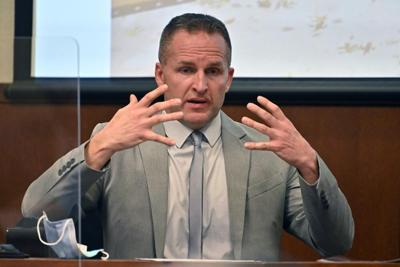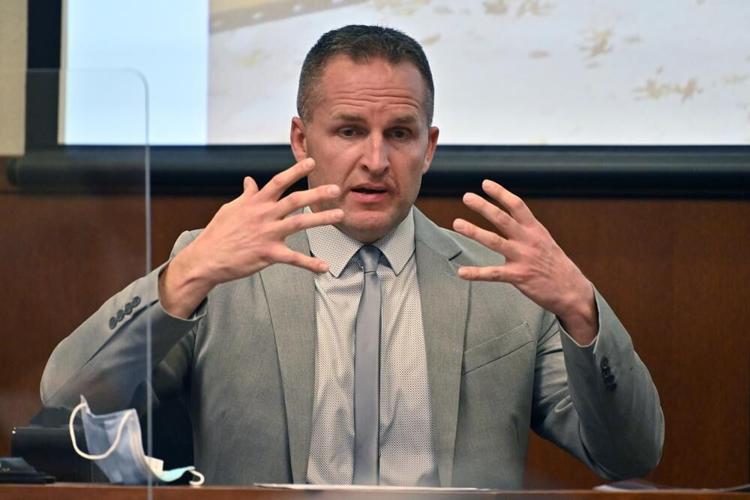LOUISVILLE, Ky. (WDRB) -- A federal judge ruled against prosecutors presenting evidence in former Louisville police detective Brett Hankison's upcoming trial that he repeatedly endangered other officers and citizens even before his alleged criminally reckless actions during the March 13, 2020, Breonna Taylor raid.
U.S. District Court Judge Rebecca Grady Jennings ruled Thursday that prosecutors have not provided enough evidence to prove that the prior incidents occurred, that Hankison's actions were "substantially" similar to those in his criminal charges or that the force used in the incidents was excessive.
Jennings left open the possibility that prosecutors could provide more evidence of the reckless actions and said she could change her mind.
Federal prosecutor Michael Songer previously told the judge that the two prior incidents when Hankison was a police officer show "similar intent" as his actions in the Taylor raid and "compelling evidence" that his motive as an officer was to "punish" suspects.
As part of Hankison's trial next week on two counts of civil rights violations and using excessive force, prosecutors wanted officers to testify about the "aggressive" incidents involving the former detective, including driving the wrong way down Dixie Highway holding his gun out the window.
But the judge ruled prosecutors did not present evidence proving Hankison's actions, such as an internal police investigation, even though Hankison's attorneys do not deny the incidents occurred.
Given the lack of evidence provided, prosecutors also must prove the actions were "excessive" and have similarities to the allegations in the Taylor case, the judge ruled.
In both incidents, according to a motion filed by prosecutors, Hankison "responded in an overly aggressive manner with his weapon drawn, disregarded his training ... and endangered his fellow officers and civilians by needlessly escalating the law enforcement response."
Prosecutors argue that Hankison was reprimanded by his supervisor for both incidents and should have been aware by the time of the Taylor raid that "such conduct was unacceptable." He was told by a supervisor "You can't do this anymore."
But LMPD did not initiate an investigation in either case, meaning no paper trail exists, and prosecutors are dependent on the testimony of officers.
It was SWAT commanders that complained to Hankison's supervisor that he violated their procedures. Both times, Hankison's supervisor said he counseled the detective.
In a hearing last month, the judge asked if Hankison's training, or lack of it, was brought up after the incidents, but the defense said Hankison was not a member of SWAT and had never received SWAT training.
Hankison's supervisor, according to the defense, does not even remember the particulars of the incidents and there was no formal written reprimand or investigation launched by the chief.
Jennings also denied a motion from prosecutors to keep out evidence that two long rifle casings were found inside and outside of Taylor's apartment after the fatal March 13, 2020 raid.
Hankison initially told police investigators that as officers burst into Taylor's apartment, he saw someone inside holding a gun he was "certain" was an AR-15 semi-automatic rifle. No rifle was found at the scene.
Former Attorney General Daniel Cameron concluded that Taylor's boyfriend, Kenneth Walker, fired a single shot from a 9 mm pistol, the only shot fired at police. Hankison has since acknowledged he was wrong about a rifle being fired at police.
Regardless, the judge said the jury can decide whether the rifle casings have any evidential value.
"The Court is confident that the jury can consider the facts surrounding the discovery of the two rifle casings and weigh the evidence presented by the parties," according to the ruling. "If anything, Hankison's admission, that he was mistaken in his perception on the night of the execution of the search warrant, should lessen or eliminate any concerns about the jury being misled."
Still, she warned both sides not to "recklessly mislead the jury on issues regarding the rifle casings."
In the Taylor raid, Hankison is accused of firing 10 times from outside her apartment through a covered sliding glass door and blinded windows in Taylor's bedroom window, with three bullets flying into an adjacent apartment where Cody Etherton, Chelsey Napper and her 5-year-old child lived.
His trial is scheduled to begin Oct. 15 and expected to last two to three weeks. The judge will summons 150 potential jurors and seat 16, including four alternates.
In 2020, police sought out a search warrant for Taylor's home as part of a broader investigation that focused on drug suspect Jamarcus Glover. Police believed Glover may have been using Taylor's apartment to receive drugs and store money.
Walker, Taylor's boyfriend, admitted to firing at police as they entered the apartment but claimed he believed the officers were intruders. He hit former officer Jonathan Mattingly.
Multiple Louisville Metro Police officers returned fire, killing Taylor. No drugs were found in her home.
This will be Hankison's third trial related to his actions the night of the raid. A federal jury in November 2023 deadlocked on two counts of civil rights violations and using excessive force.
A state Jefferson Circuit Court jury in March 2022 found Hankison not guilty on three counts of wanton endangerment.
While the evidence of the rifle casings was used in previous trials, prosecutors did not include the evidence of Hankison being counseled for previous reckless actions.
The two incidents both happened during the execution of search warrants, in 2016 and 2017, and show that Hankison's actions in the Taylor raid were "not a tactical miscalculation undertaken in good faith, but rather a willful act taken to punish someone who the defendant perceived had wronged the police," according to prosecutors.
On Oct. 19, 2016, a SWAT commander called Hankison's actions "reckless" when he drew his handgun as police watched a drug deal, yelled "he's on the roof!" and ran between the suspect and the SWAT officers who had their rifles drawn, according to the motion.
"Fortunately, the defendant's actions did not trigger crossfire, and SWAT officers eventually" arrested the suspect without injuries. But "officers on the scene remembered the incident even years later" and have told prosecutors that Hankison's interference put everyone in danger, the motion alleges.
The SWAT commander spoke with Hankison's supervisor who counseled the detective.
In the other incident, on May 31, 2017, police were executing a search warrant at a barbershop on Dixie Highway when Hankison "aggressively" entered the scene, speeding the wrong way with his gun pointed out the window, according to the motion.
Prosecutors say a SWAT officer told Hankison's supervisor he needed to "reel" him in. "The supervisor recounted that he then 'ripped (Hankison's) ass.'"
During the previous federal trial, LMPD officers testified that Hankison's actions on the night of the Taylor raid were "shocking," unfathomably dangerous" and "stomach churning."
Jennings denied a motion from Hankison's attorneys to "exclude characterizations of his use of force" by these other officers.
Prosecutor Michael Songer, with the U.S. Department of Justice, told jurors last year that Hankison fired "blindly, spraying bullets through two covered windows, ripping through walls into a neighboring apartment" where a family and a child were sleeping.
Former defense attorney Stew Mathews told jurors last year they would have to put themselves in Hankison's shoes at the time, think about what he was seeing and experiencing as an officer was shot and dozens of bullets were fired after they burst into Taylor's home.
"If someone fires at the police, the police are going to fire back at you, and that's exactly what happened here," Mathews said.
Hankison testified he wasn't part of the investigation leading up to the raid and didn't even know the adjacent apartment was there. All Hankison knew was that fellow officers were under fire, he believed from an assault rifle, and that one officer had been shot.
He admitted he was mistaken, and the muzzle flashes were actually coming from Mattingly and Det. Myles Cosgrove, and that Walker only fired one shot from a handgun at police.
"Was I wrong that Mr. Walker shot more than one shot? I know that now," Hankison testified. "I fired to stop the threat, sir."
But he said if given a chance for a do-over, he "would do the exact same thing" because he was trying to save the lives of his fellow officers.
This story may be updated.
Related Stories:
- Two former Louisville police officers involved in Breonna Taylor raid have been indicted again
- DOJ appeals dismissal of most serious charges against 2 officers involved in Breonna Taylor raid
- Federal judge dismisses most serious charges against 2 officers involved in Breonna Taylor raid
- TRANSCRIPT | US Attorney General announces federal charges in death of Breonna Taylor
Copyright 2024 WDRB Media. All Rights Reserved.




